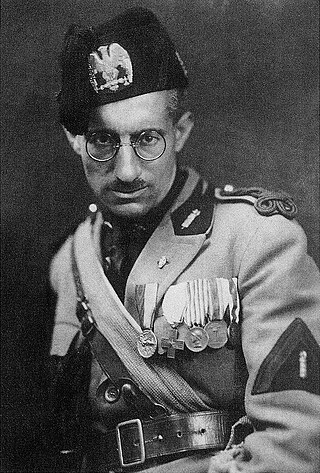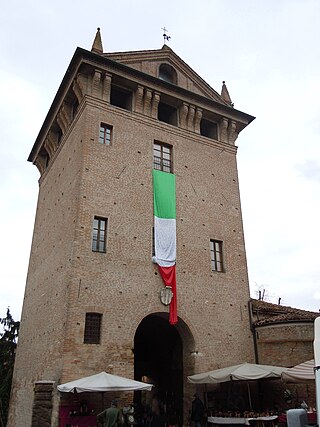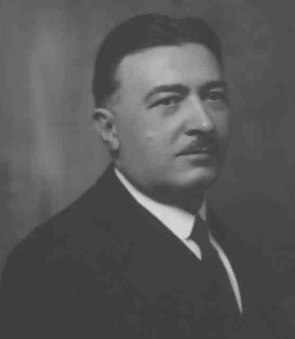Related Research Articles

Michele Bianchi was an Italian revolutionary syndicalist leader who took a position in the Unione Italiana del Lavoro (UIL). He was among the founding members of the Fascist movement. He was widely seen as the dominant leader of the leftist, syndicalist wing of the National Fascist Party. He took an active role in the "interventionist left" where he "espoused an alliance between nationalism and syndicalism." He was one of the most influential politicians of the regime before his succumbing to tuberculosis in 1930. He was also one of the grand architects behind the "Great List" which secured the parliamentary majority in favor of the fascists.

Alceste De Ambris was an Italian syndicalist, the brother of fascist politician Amilcare De Ambris. He was a Freemason and had a major part to play in the agrarian strike actions of 1908 in Parma.
Fascio is an Italian word literally meaning "a bundle" or "a sheaf", and figuratively "league", and which was used in the late 19th century to refer to political groups of many different orientations. A number of nationalist fasci later evolved into the 20th century Fasci movement, which became known as fascism.

The Italian Socialist Party was a social-democratic and democratic-socialist political party in Italy, whose history stretched for longer than a century, making it one of the longest-living parties of the country. Founded in Genoa in 1892, the PSI was from the beginning a big tent of Italy's political left and socialism, ranging from the revolutionary socialism of Andrea Costa to the Marxist-inspired reformist socialism of Filippo Turati and the anarchism of Anna Kuliscioff. Under Turati's leadership, the party was a frequent ally of the Italian Republican Party and the Italian Radical Party at the parliamentary level, while lately entering in dialogue with the remnants of the Historical Left and the Liberal Union during Giovanni Giolitti's governments to ensure representation for the labour movement and the working class. In the 1900s and 1910s, the PSI achieved significant electoral success, becoming Italy's first party in 1919 and during the country's Biennio Rosso in 1921, when it was victim of violent paramilitary activities from the far right, and was not able to move the country in the revolutionary direction it wanted.

The Fasci Italiani di Combattimento was an Italian fascist organisation created by Benito Mussolini in 1919. It was the successor of the Fascio d'Azione Rivoluzionaria, being notably further right than its predecessor. The Fasci Italiani di Combattimento was reorganised into the National Fascist Party in 1921.

Gonzaga is a comune (municipality) in the Province of Mantua in the Italian region Lombardy, located about 140 kilometres (87 mi) southeast of Milan and about 25 kilometres (16 mi) south of Mantua. Located in a region known as the "Lower Mantuan" is notable for being the ancestral home of the House of Gonzaga, rulers of the Duchy of Mantua between 1328 and 1707.
Squadrismo was the movement of squadre d'azione, the fascist militias that were organised outside the authority of the Italian state and led by local leaders called ras. The militia originally consisted of farmers and middle-class people, who created their own defence from revolutionary socialists. Squadrismo became an important asset for the rise of the National Fascist Party, led by Benito Mussolini, and systematically used violence to eliminate any political parties that were opposed to Italian Fascism.

Chamber of Fasces and Corporations was the lower house of the legislature of the Kingdom of Italy from 23 March 1939 to 5 August 1943, during the height of the regime of Benito Mussolini's National Fascist Party.
This is a list of words, terms, concepts, and slogans in the Italian language and Latin language which were specifically used in Fascist Italian monarchy and Italian Social Republic.
The Pact of Pacification or Pacification Pact was a peace agreement officially signed by Benito Mussolini, who would later become dictator of Italy, and other leaders of the Fasci with the Italian Socialist Party (PSI) and the General Confederation of Labor (CGL) in Rome on August 2 or 3, 1921. The Pact called for “immediate action to put an end to the threats, assaults, reprisals, acts of vengeance, and personal violence of any description,” by either side for the “mutual respect” of “all economic organizations.” The Italian Futurists, Syndicalists and others favored Mussolini’s peace pact as an attempt at “reconciliation with the Socialists.” Others saw it as a means to form a “grand coalition of new mass parties” to “overthrow the liberal systems,” via parliament or civil society.
Massaie Rurali was an Italian organisation for peasant women within the Italian Fascist Party (PNF). MR was founded in 1933 and disbanded in 1945. It was the largest women's organisation in Fascist Italy and one of the largest organisations, with more than three million members in 1943.
Fasci Femminili (FF) ("Female Groups") was the women's section of the Italian Fascist Party (PNF). The FF was founded in 1919 and disbanded in 1945. It incorporated all the other Fascist organizations for women and girls, which were all formally sections of the FF.

Stefano Cavazzoni (1881–1951) was an Italian politician who served as the minister of labour between October 1922 and April 1923. He was also a member of the parliament and senate.
Angiola Moretti, was an Italian politician of the National Fascist Party (PNF).
Elisa Majer Rizzioli (1880-1930), was an Italian politician of the National Fascist Party (PNF).
Giuditta "Itta" Stelluti Scala Frascara was an Italian politician of the National Fascist Party (PNF).
Clara Franceschini, was an Italian politician of the National Fascist Party (PNF).
Baroness Teresita Menzinger Ruata, was an Italian politician of the National Fascist Party (PNF).
Wanda Bruschi Gorjux (1889-1976), was an Italian politician of the National Fascist Party (PNF).

Olga Medici del Vascello (1882-1966), was an Italian politician of the National Fascist Party (PNF).
References
- ↑ Willson, Perry. “The Fairytale Witch: Laura Marani Argnani and the Fasci Femminili of Reggio Emilia, 1929-1940.” Contemporary European History, vol. 15, no. 1, 2006, pp. 23–42. JSTOR, http://www.jstor.org/stable/20081293. Accessed 29 July 2023.
- ↑ de Grazia, V. (1992). How Fascism Ruled Women: Italy, 1922–1945. USA: University of California Press.